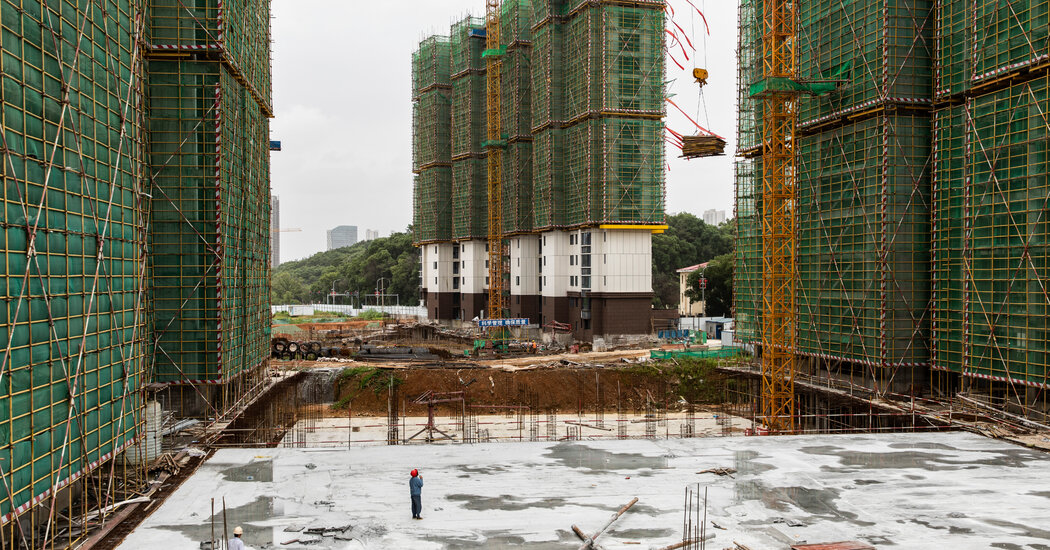Global Courant 2023-05-25 18:09:17
The rows of towering buildings that crowd the banks of the Gan River are testament to the real estate boom that transformed eastern China’s Nanchang from a gritty manufacturing hub to a modern urban center.
Now those skyscrapers are evidence of something completely different: China’s real estate market in crisis, reeling after years of overbuilding.
As China’s economy boomed over the past two decades, Nanchang, the capital of Jiangxi province, built impressive apartment complexes and gleaming office towers to meet the increasing demand for housing and workplaces. It pursued urban sprawl with a motto that underscored its approach to growth at all costs: “Go east, expand south, expand west, integrate north, and prosper in the middle.”
But the country’s protracted real estate crisis has exposed cracks in cities such as Nanchang, where years of non-stop construction have oversupplied. With one measure nearly 20 percent of the homes in Nanchang are vacant – the highest percentage of 28 large and medium-sized Chinese cities.
Nanchang illustrates the enormous challenges policymakers face in trying to revive China’s economy. During previous downturns, Beijing turned to investment in real estate and infrastructure to jump-start its economy. But this time it won’t be an easy fix. Developers are saddled with debt, cities are teeming with vacant homes and local government finances are drained from years of paying for Covid testing.
Many of Nanchang’s newest apartments are vacant as developers ran out of money and did not finish units already sold. Some homeowners are refusing to pay mortgages until their apartments are ready, a nationwide act of dissent that has upset the Chinese Communist Party.
Over the past year, Beijing and local governments have unleashed incentives to lure homebuyers back, urge banks to lend liberally and reverse curbs put in place before the pandemic to cool an overheated housing market.
New home prices in China’s 70 largest cities rose in each of the first four months of the year, reversing a year-long decline during the height of Covid restrictions. But the burgeoning rebound loses momentum. House price growth slowed in April.
And the recovery is not evenly distributed. Prices have shot up again in larger cities such as Beijing and Shanghai. In second-tier cities such as Nanchang, the upswing was more muted and even absent in smaller cities.
China’s housing problems are more pronounced outside of the top cities as overbuilding is more pervasive in smaller cities, according to a newspaper from Kenneth Rogoff, an economics professor at Harvard, and Yuanchen Yang, an economist at the International Monetary Fund.
Dr. Rogoff said China’s housing boom was based on “forever rapid growth,” but that in many smaller cities, the economy had not kept pace with housing construction.
“China has been building real estate and supporting infrastructure at a breakneck pace for decades,” he said. “Ultimately you run into diminishing returns.”
China’s housing boom began in the late 1990s in the largest cities and spread to smaller urban areas such as Nanchang in the 2000s. In 2000, China built about two million apartments. By the mid-2010s, it was building more than seven million apartments a year. Real estate quickly became the backbone of China’s economy, accounting for about a quarter of all activity.
The industry created jobs, supported the finances of local governments that leased land rights for new buildings, and provided one of the few reliable investment opportunities for ordinary Chinese looking to accumulate wealth. As the economy became more reliant on real estate, China’s top leader Xi Jinping cracked down on debt-laden developers, declaring that “houses are for living, not speculating.”
In places like Nanchang, more was built than population growth alone could support. In the decade leading up to 2021, the annual amount of housing construction in the city has roughly doubled, while the population increased by 25 percent.
Kuang Wei, a resale property broker in Nanchang, said prices in the more remote part of the city where he works have fallen steadily, by 25 percent since 2019.
He expects prices to drop further as so many people try to sell. Some want to upgrade to newer apartments, while others want to unload investment properties before an expected property tax is implemented. Mr Kuang said about 80 percent of his customers still refused to lower prices, hoping the market would recover.
“Today’s market is not like it was many years ago,” he said.
Nanchang’s 20 percent housing vacancy rate was higher than the 12 percent average among a nationwide sample, according to an August report by China’s Beike Research Institute. Rising vacancy rates attracted a lot of attention as they confirmed China’s real estate problems were bigger than Beijing had let on.
After publication, Beike deleted the report, saying it collected information “incorrectly” and that the data “did not reflect the real situation.”
Traditionally, Nanchang’s economy has depended on manufacturing and construction. It has tried without much success to land higher-paying jobs in the digital economy and technology industry.
Nanchang is known as the city where Chinese Communist Party rebels first defeated the Nationalists nearly a century ago. Nanchang is surrounded by other cities that are more attractive options for offices.
Nanchang had the same number of buildings taller than 200 meters, or about 60 stories, as Beijing in 2022. However, Beijing’s population was three times as large and was the second largest city by economic output. By comparison, Nanchang is 36th. In 2021, the commercial real estate company JLL said office vacancy in Nanchang was up 40 percent.
Cinderella Fang, 28, was born and raised in Nanchang. Growing up, most apartments were in low, walkable buildings and there were no planned communities. She said the area near her childhood home had turned into a sprawl of 30-story apartment complexes.
After attending a university in Beijing, Ms. Fang returned to Nanchang in 2019 hoping to find some work and possibly buy an affordable house. But she moved to Shanghai after a month because the only job she could find in Nanchang was a marketing position that paid a third of what she earned in Beijing.
“The labor market in Nanchang has not been very good,” said Ms. Fang.
Other transplants to Nanchang have been drawn to the prospect of reasonably priced apartments and strong public schools – only to run into developers unable to deliver the promised homes.
Shortly after the birth of her daughter in 2019, Andie Cao, who lives and works in Shanghai, bought an unfinished apartment in Nanchang. It was closer to her hometown in rural China, and she planned to move after the developer would complete the project in late 2021.
But the developer ran into financial trouble and stopped construction in July 2021. After Ms. Cao had paid the mortgage for a year, Ms. Cao and other homeowners staged a mortgage boycott last July.
Ms. Cao said the sellers had also told her that the apartment was in one of Nanchang’s more established districts with good schools, but was actually intended for an adjacent, less developed area on the outskirts of the city.
“Everyone has been cheated,” she said. “Why else would so many people buy a house in the suburbs?”
She said she continued to boycott because the houses were not finished yet. She said the police had visited her parents to find Ms. Cao to stop speaking out. The banks are now suing some of its boycotting neighbors.
“It’s like smashing an egg against a rock,” said Ms. Cao. “I didn’t expect this kind of thing to happen to ordinary people like us.”
Zou Shengji, a real estate agent in Nanchang, said the negative publicity about the unfinished apartments had left many potential homebuyers “scared and worried”.
During the Labor Day holiday in early May, usually a busy time for home sales, Mr. Would be less than 20 apartments, he said. It sold triple that amount in the same period two years ago.
Potential clients say they’ll come and see the apartments, but don’t show up, he said. Customers are reluctant to buy because real estate feels too risky right now.
“A lot of people are on the fence now,” Mr Zou said. “Houses may become very difficult to sell in the future.”








